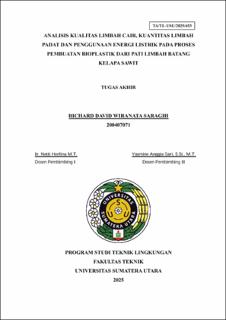| dc.contributor.advisor | Herlina, Netti | |
| dc.contributor.advisor | Sari, Yasmine Anggia | |
| dc.contributor.author | Saragih, Richard David Wiranata | |
| dc.date.accessioned | 2025-04-14T01:19:44Z | |
| dc.date.available | 2025-04-14T01:19:44Z | |
| dc.date.issued | 2025 | |
| dc.identifier.uri | https://repositori.usu.ac.id/handle/123456789/102906 | |
| dc.description.abstract | The agricultural sector plays an important role in the Indonesian economy. Palm oil is
one of the leading commodities in the agricultural sector in Indonesia. According to
Asmar Arsjad (2017), there are around 1.5 million hectares of the millions of hectares of
oil palm plantations owned by farmers that urgently need to be rejuvenated (replanted).
However, this replanting activity also has a negative impact on the environment due to
the large number of oil palm trunks from felling which can disrupt plantation
management if left alone in the plantation area. Basically, we can reuse the waste, one
of which is the utilization of palm oil trunk starch into bioplastic. Making bioplastic
requires less energy and costs compared to making conventional plastic. However,
although making bioplastic requires less energy, making bioplastic can still have
negative impacts on the environment such as the release of carcinogenic compounds,
eutrophication, or unused wood waste from palm oil trunks which can cause emissions
or liquid and solid waste. This study will look at the quality of liquid waste, quantity of
solid waste and use of electrical energy in the process of making bioplastic from palm
oil trunk waste starch. The parameters of liquid waste that will be analyzed in this study
are BOD using the SNI 06.6989.72:2009 method, COD and TSS parameters using the
Spectrophotometry method, TDS parameters using the Electrometry method, and pH
will be measured directly. In measuring the quantity of solid waste, it will be calculated
directly using a scale and the use of electrical energy using a kWh meter. The results of
the study showed that the quality of liquid waste is still dominantly on the threshold of
the quality standard according to PermenLH no.5 of 2014. The quantity of solid waste
obtained in this study was 850 grams, and the use of electricity during the process of
making bioplastic from palm oil waste starch was 1,095 kWh and if converted to rupiah
it is Rp.1,667.51. | en_US |
| dc.language.iso | id | en_US |
| dc.publisher | Universitas Sumatera Utara | en_US |
| dc.subject | Bioplastic | en_US |
| dc.subject | Palm Oil Waste | en_US |
| dc.subject | Liquid Waste | en_US |
| dc.subject | Solid Waste | en_US |
| dc.subject | Use Of Electrical Energy | en_US |
| dc.subject | BOD | en_US |
| dc.subject | COD | en_US |
| dc.subject | TSS | en_US |
| dc.subject | TDS | en_US |
| dc.subject | pH | en_US |
| dc.title | Analisis Kualitas Limbah Cair, Kuantitas Limbah Padat dan Penggunaan Energi Listrik pada Proses Pembuatan Bioplastik dari Pati Limbah Batang Kelapa Sawit | en_US |
| dc.title.alternative | Analysis of Liquid Waste Quality, Solid Waste Quantity and Electrical Energy Use in the Process of Making Bioplastics from Palm Oil Bar Waste Starch | en_US |
| dc.type | Thesis | en_US |
| dc.identifier.nim | NIM200407071 | |
| dc.identifier.nidn | NIDN0025046006 | |
| dc.identifier.nidn | NIDN0023108903 | |
| dc.identifier.kodeprodi | KODEPRODI25201#Teknik Lingkungan | |
| dc.description.pages | 63 Pages | en_US |
| dc.description.type | Skripsi Sarjana | en_US |
| dc.subject.sdgs | SDGs 6. Clean Water And Sanitation | en_US |


